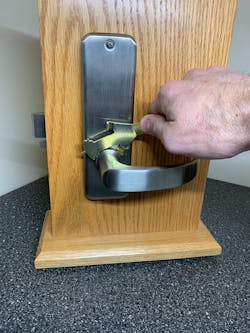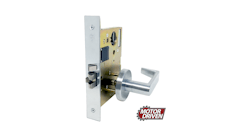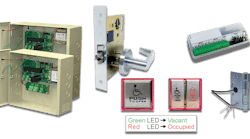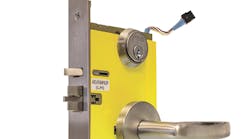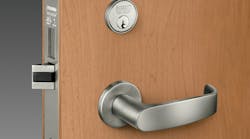Locksmiths are often called out in the field to diagnose and service malfunctioning cylindrical and mortise locks. I know from personal experience that it’s not unusual to end a day thinking to yourself, “Now I’ve heard everything!” Without fail, the next day you’ll find that you hadn’t because someone calls with a new and unique problem.
Here are some steps to take to avoid or resolve common mortise and cylindrical lock issues.
Determine the exact nature of the issue. A mismatch between the hardware and its proposed operation will often be the root of a service issue. Since you are probably going to use new as well as used hardware, it is best to keep an open mind when approaching the problem door. A lock is only one element of the door assembly, and all the components work together to provide a functioning opening.
Check the condition of the door. Is the door in working order? Are parts missing? Has the door or hardware been painted which prevents its intended operation? Was the door subjected to “blunt force trauma?” That’s an expression they use to describe when the victim has been physically attacked and injured, and it applies to doors as well as people. Such damage can be subtle or obvious, and many times the damage may require replacement of the door, the frame, door hardware, or even the adjoining walls or building structure.
Problems often result from the following issues:
Site environment issues: Debris, loose parts, and vandalism may be the root issue of the problem and specifically the lock or door hardware.
Stacking Pressure: This is created by HVAC systems putting air pressure on a door and binding of the door and the lock latch may result. There are electric strikes designed to operate where stacking pressure prevails. Door closers may also be installed on the door, or be adjusted to maintain the door in its required zero position.
Door/jamb misalignment: When the door jamb “racks,” it distorts and is no longer as plumb or square as it was or needs to be in order for the door to swing and close freely.
Latch/strike interference: While the door opens and shuts, the door closer may not have been doing its job to help cushion the shock of the slamming door, Consequently, strike and latches often become damaged and misaligned. Doors being subjected to attempted forced entry will also have internally compromised hardware components which may not be immediately apparent, or may be intermittent. The technician must be mindful and observant to identify such problems.
Door hinge issues: Since the hinges carry the weight of the door, they can show signs of wear or may become misaligned, resulting in the loss of the proper geometry between the door, the frame and the latch, door strike and other door hardware. Sometimes obstructions placed between the door and frame will cause profound damage to the door, the hinge and the frame, and may require extra innings to resolve. If the hinge pockets or door itself were damaged by operating with improperly installed or adjusted hinges, continuous hinges, pivots, and repair components are available which may help resolve the issues without major surgery. (sorry, another medical metaphor!)
An Expert Weighs In
Locksmith Ledger interviewed dormakaba’s Glen Davies CPL, AFDI, GSA-SVT, learning leader – door hardware, for some expert tips. Following are Ledger’s questions and Davies’ answers.
Locksmith Ledger: What are the one or two most important tech tips for installing a mortise or cylindrical lock?
Glen Davies: It is usually easier to install the mortise cylinder if the lock case is left a bit loose until after the cylinder is installed. Leaving it a little loose allows for pushing or pulling of the latch or deadbolt to angle the lock case to be perpendicular to the mortise cylinder.
Ensure the portions of the mortise lock (BEST calls them trim cassettes) that support the levers or knobs are fully tightened and aligned per the manufacturer’s instructions. Spindle breakage can occur when the center portion of a swivel spindle is unsupported by the trim cassettes.
With cylindrical locks, always check that the lock is adjusted correctly for the thickness of the door. If it is not adjusted properly, a lock-out or lock-in situation could occur due to the latch disconnecting from the lock chassis. Lock-ins have led to lawsuits and could be deadly.
LL: What are the one or two most important tech tips to keep in mind when adjusting a mortise or cylindrical lock?
Davies: Do not overtighten the trim or through bolts. Screws and bolts need to be tight, but not too tight. You could crush a door or the trim by tightening too much. If the screws or bolts will not remain tight, apply a liquid thread locker, such as Loctite 243, to them.
If the latch does not easily retract and fall into the strike opening, it could be a lack of lubrication, or a gritty latch. Spray a little lubricant, such as Houdini Lock Lube, Tri-Flow or Corrosion Free Formula 8000 on the latch, wipe off any visible dirt or grit and apply a little more lubricant to the latch.
ANSI Grades are Important
Applicable standards are ANSI/BHMA A156.13-2017 American National Standard For Mortise Locks & Latches and ANSI/BHMA A156.2-2017 Bored And Assembled Locks And Latches.
These standards establish the performance requirements including dimensional criteria, operational tests, strength tests, cycle tests, security tests, material evaluation tests, and finish tests. Tests described in these standards are performed under laboratory conditions. In actual usage, results vary because of installation, door and frame construction, maintenance and environmental conditions.
Manufacturers are also required to indicate the Grade level of their locks. Locks shall meet all tests for their grade listing. For example, a Grade 1 lock shall meet all Grade 1 criteria.
A locking device may not perform as expected if the grade or function do not match the installation environment.
It’s important to use the hardware supplied by the manufacturer to install the lock for the particular situation (examples: wood, hollow metal, concrete, indoor outdoor exposed to the elements).
If the hardware uses external electrical power, confirm that the power is within the device’s requirements as it relates to AC/ DC, ampacity, and allowable min/max levels.
Tim O’Leary is an experienced security consultant and a regular contributor to Locksmith Ledger.
